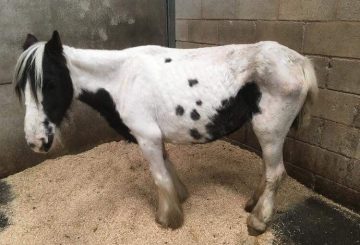Horses unlike human patients do not always realise when they have to take it easy so it is unfortunately inevitable that when they are injured they will have to be confined on Box Rest.
This can be a stressful time for both owner and horse alike especially if your horse was competition fit and “full of beans” when he sustained the injury. Even if he is a pleasure horse and is used to a routine he will not be too pleased at enforced imprisonment. The first few weeks are generally the worst and after this time the horse will get used to it and accept his fate.
It is well known that a change it any routine can be stressful to horses and stress in itself can cause stomach changes such as glandular disease (ulcers). Any change in the horse’s diet should always be done slowly, allowing the microflora in the hind gut to adjust accordingly. However, should your horse be 3 day event fit and then has a tendon injury you obviously cannot feed high energy carbohydrate whilst he is on rest! The feed companies are very useful for advice in these situations, but as a general rule you should substitute for a lower energy mix or nut initially, and then reduce the volume over a few days to a week or thereabouts. In most situations ad lib good quality forage supplemented by a forage balancer should be sufficient for horses on long term box rest. The aim is to supply enough energy for maintenance of the body condition as well as tissue repair and to replicate “normal” grazing behaviour as far as possible. Horses are trickle feeders and will eat for about 17 hours a day in the wild, moving about as they do so which aids digestion.
A common problem of box rest is impacted colic where the horse gets bunged up, usually at the U bend in the gut; the pelvic flexure, as the ingesta passing through is drier than the norm. This is especially true where horses have previously had access to pasture and are getting moisture from the grass. Horses on box rest do not drink sufficiently to make up for this so steamed or soaked forage as well as wetting any hard feed is useful. Some horses will readily drink a slightly warm “soup” of soaked pony or grass nuts in preference to water and a couple of apples sliced into the drinking water can make it more appealing.
When grazing, horses slowly move from place to place as they eat with their heads down which is important for their respiratory health as well as stretching the top line. Horses are not giraffes- they will browse the hedge occasionally but are not designed to eat from the trees all the time. We tend to use haynets for our convenience, (not that of the horse) to save wastage and keep the stable tidy. Haynets have disavantages: The forage is at nose height and any spores of bacteria are released as a cloud into the air when the horse pulls at the hay and these contaminants then get inhaled. Therefore if the horse is unable to remove contaminants by drainage he will develop some degree of inflammatory airway disease whilst inside.
Feeding steamed forage is very important in preventing this – but it should still be fed at floor level. There are now available some nets which have small holes and are designed for low level feeding. In order to replicate natural behaviour as far as possible and to encourage the horse to move a little it can be helpful to position alternative forage, such as a little alfalfa or dried grass around the stable. Scattering a few grass nuts about can help too.
Frustrating as it is to have a horse on box rest, this time can be made easier with a little input from the owner and could eventually lead to a better relationship between horse and rider.
For more information, please visit www.haygain.co.uk.


